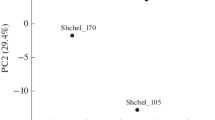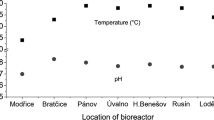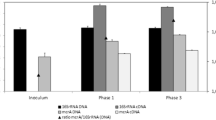Abstract
Joint cultivation of the dominant strains of acetogenic, sulfate-reducing and methanogenic microorganisms isolated from water samples of the North Stavropol underground gas storage facility (UGSF) was carried out for revealing their probable trophic relationships. It was shown that acetogenic strains Eubacterium limosum AG12 and Sporomusa sphaeroides AG8-2 growing on methanol could form a considerable pool of hydrogen, which may support development of hydrogenotrophic cultures, the methanogen Methanobacterium formicicum MG134, or the sulfate reducer Desulfovibrio desulfuricans SR12. Growth of this sulfate-reducing strain was not stimulated under joint cultivation with Methanosarcina barkeri MGZ3 on methanol, probably due to its inability to take up low hydrogen concentrations observed during methanosarcina development. The results show that acetogens in the UGSF system are the most important consumers of methanol and hydrogen and after exhaustion of the latter and switching over to methanol utilization they can supply hydrogen to other microorganisms, including methanogens and sulfate reducers. The role of methanosarcina in the UGSF increases as the hydrogen and CO2 reserves are exhausted, and methanogenesis on methanol becomes the main way of its destruction.
Similar content being viewed by others
References
Ivanova, A.E., Borzenkov, I.A., Tarasov, A.L., Milekhina, E.I., and Belyaev, S.S., A Microbiological Study of an Underground Gas Storage in the Process of Gas Injection, Mikrobiologiya, 2007, vol. 76, no. 4, pp. 515–523 [Microbiology (Engl. Transl.), vol. 76, no. 4, pp. 453–460].
Ivanova, A.E., Borzenkov, I.A., Tarasov, A.L., Milekhina, E.I., and Belyaev, S.S., A Microbiological Study of an Underground Gas Storage in the Process of Gas Extraction, Mikrobiologiya, 2007, vol. 76, no. 4, pp. 524–532 [Microbiology (Engl. Transl.), vol. 76, no. 4, pp. 461–468].
Kerby, R., Neimczura, W., and Zeikus, J.G., Single-Carbon Catabolism in Acetogens: Analysis of Carbon Flow in Acetobacterium woodii and Butyribacterium methylotrophicum by Fermentation and 13C Nuclear Magnetic Resonance Measurement, J. Bacteriol., 1983, vol. 155, pp. 1208–1218.
Tarasov, A.L., Borzenkov, I.A., Chernykh, N.A., and Belyaev, S.S., Isolation and Investigation of Anaerobic Microorganisms Involved in Methanol Transformation in an Underground Gas Repository, Mikrobiologiya, 2011, vol. 80, no. 2, pp. [Microbiology (Engl. Transl.), vol. 80, no. 2, pp.].
Lynd, L.H. and Zeikus, J.G., Metabolism of H2-CO2, Methanol, and Glucose by Butyribacterium methylotrophicum, J. Bacteriol., 1983, vol. 153, pp. 1415–1423.
Finke, N., Hoehler, T.M., and Jörgensen, B.B., Hydrogen “Leakage” During Methanogenesis from Methanol and Methylamine: Implications for Anaerobic Carbon Degradation Pathways in Aquatic Sediments, Environ. Microbiol., 2007, vol. 4, pp. 1060–1071.
Cord-Ruwisch, R., Seitz, H.-J., and Conrad, R., The Capacity of Hydrogenotrophic Anaerobic Bacteria to Compete for Traces of Hydrogen Depends on the Redox Potential of the Terminal Electron Acceptor, Arch. Microbiol., 1988, vol. 149, pp. 350–357.
Krumholz, L.R., Harris, S.H., Tay, S.T., and Suflita, S.M., Characterization of Two Subsurface H2-Utilizing Bacteria, Desulfomicrobium hypogeium sp. nov. and Acetobacterium psammolithicum sp. nov., and Their Ecological Roles, Appl. Environ. Microbiol., 1999, vol. 65, pp. 2300–2306.
Zhilina, T.N. and Zavarzin, G.A., Trophic Interactions between Methanosarcina and Its Associations, Mikrobiologiya, 1973, vol. 42, no. 2, pp. 226–273.
Phelps, T.J., Conrad, R., and Zeikus, J.G., Sulfate-Dependent Interspecies H-2 Transfer between Methanosarcina barkeri and Desulfovibrio vulgaris during Coculture Metabolism of Acetate or Methanol, Appl. Environ. Microbiol., 1985, vol. 50, pp. 589–594.
Zhilina, T.N., Development of a Pure Methanosarcina Biotype culture on Acetate, Mikrobiologiya, 1978, vol. 67, no. 3, pp. 396–399.
Nanninga, H.J. and Gottschal, J.C., Properties of Desulfovibrio carbinolicus sp. nov. and Other Sulfate-Reducing Bacteria Isolated from an Anaerobic-Purification Plant, Appl. Environ. Microbiol., 1987, vol. 53, pp. 802–809.
Oremland, R.S. and Polcin, S., Methanogenesis and Sulfate Reduction: Competitive and Noncompetitive Substrates in Estuarine Sediments, Appl. Environ. Microbiol., 1982, vol. 44, pp. 1270–1276.
Cord-Ruwisch, R. and Ollivier, B., Interspecific Hydrogen Transfer During Methanol Degradation by Sporomusa acidovorans and Hydrogenophilic Anaerobes, Arch. Microbiol., 1986, vol. 144, pp. 163–165.
Author information
Authors and Affiliations
Corresponding author
Additional information
Original Russian Text © A.L. Tarasov, I.A. Borzenkov, S.S. Belyayev, 2011, published in Mikrobiologiya, 2011, Vol. 80, No. 2, pp. 192–199.
Rights and permissions
About this article
Cite this article
Tarasov, A.L., Borzenkov, I.A. & Belyayev, S.S. Investigation of the trophic relations between anaerobic microorganisms from an underground gas repository during methanol utilization. Microbiology 80, 180–187 (2011). https://doi.org/10.1134/S0026261711020159
Received:
Published:
Issue Date:
DOI: https://doi.org/10.1134/S0026261711020159




